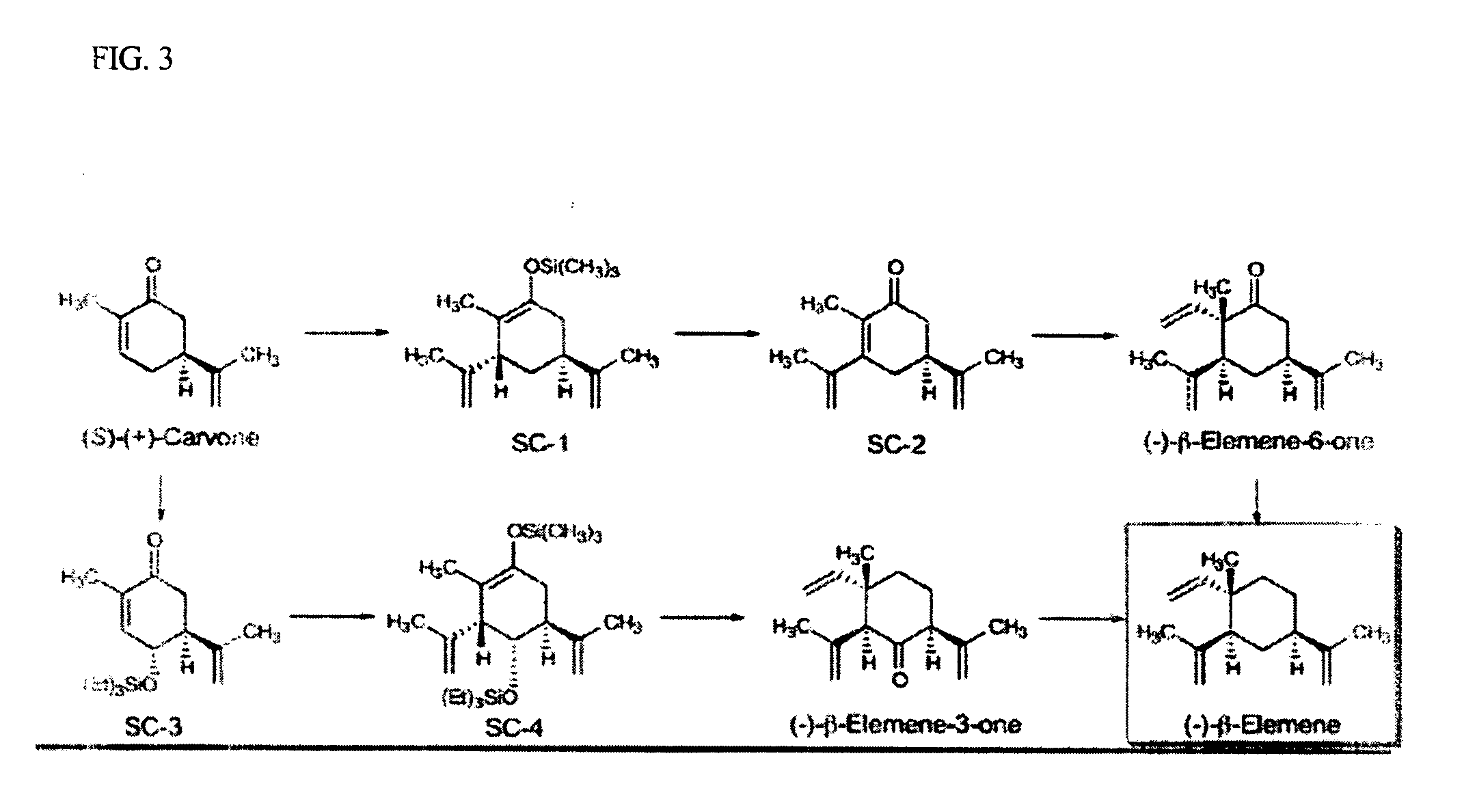Synthesis of beta-elemene, intermediates thereto, analogues and uses thereof
a beta-elemene and intermediate technology, applied in the field of elemene, can solve the problems of complex attempts to administer bcnu by arterial injection, insufficient published methods, aggressive, highly invasive, etc., and achieve the effects of reducing cell size, reducing drug concentration, and reducing tumors
- Summary
- Abstract
- Description
- Claims
- Application Information
AI Technical Summary
Benefits of technology
Problems solved by technology
Method used
Image
Examples
example 1
[0114] Synthesis of ##STR3##
[0115] (E)-Geranyl 3-Methyl-3-butenate
[0116] A solution of geraniol (225 ul, 1.29 mmol, 1.0 equivalent) and triethylamine (271 ul, 1.94 mmol, 1.5 equivalent) in dry dichloromethane (1 ml) was cooled to −78 C and treated dropwise with 3,3-dimethylacryloyl chloride (159 ul, 1.43 mmol, 1.1 equivalent). After 3 h, the solution was diluted with water (1 ml) and dichloromethane (1 ml), and the cooling hath was removed. The mixture was extracted with dichloromethane (3×20ml), and the combined organics were dried (MgSO4) and concentrated in vacuo. Purification by radial chromatography (4 mm SiO2 plate; elute, 7% EtOAc-hexanes; product, fractions 4-6; 30 ml / fraction) afforded ##STR3## (301 mg, 1.27 mmol, 99% yield) as a clear oil: Rf starting material, 0.14; product, 0.51 (5:1 hexanes-EtOAc, anisaldehyde); FTIR (film) 2970, 2919, 2858, 1738, 1653, 1445, 1377, 1206, 1153, 987, 896 cm-1; .sup. 1H NMR (400 MHz, CDCl3) δ5.31-5.35 (m, 1H), 5.04-5.08 (m, 1H), 4.88 (bs,...
example 2
[0117] Synthesis of ##STR4a##
[0118] (2S, 3S)-2-Isopropenyl-3,7-dimethyl-3-vinyl-6-octenoic Acid
[0119] The 3,5-bis(trifluoromethyl)benzenesulfonamide of (R,R)-1,2-diphenyl-1,2-diaminoethane (718 mg, 0.940 mmol, 1.0 equivalent) was dried under vacuum at 70 C for 3 h. The reaction flask was then evacuated and flushed three times with dry N2. Freshly distilled dichloromethane (32 ml) was added, and the homogeneous solution was cooled to −78 C. After 10 min, freshly distilled Bbr3 (3.76 ml, 0.5 M in CH2C12, 1.88 mmol, 2.0 equivalent) was added and the solution was stirred for 5 min at −78 C and then warmed to 23 C. After 16 h, all volatile materials were removed under vacuum, the resulting white solid was redissolved in dichloromethane (20 ml), and the solution was concentrated again. After 60 min, the flask was evacuated and flushed three times with N2, and the resultant white solid was dissolved in freshly distilled toluene (32 ml). The bromoborane complex (##STR1##) was cooled to −78...
example 3
[0120] Synthesis of ##STR4b##
[0121] (2S, 3S)-2-Isopropenyl-3,7-dimethyl-3-vinyl-6-octenol A mixture of ##STR4a## and minor diastereomer (18 mg, 0.076 mmol, 1.0 equivalent) in dry diethyl ether (2 ml) was treated with LiAlH4 (15 mg, 0.381 mmol, 5.0 equivalent) at 23 C.
[0122] After 12 h, additional LiAlH4 (15 mg, 0.381 mmol, 5.0 equivalent) and diethyl ether (2 ml) were added. After an additional 12 h, H2O (50 ul), NaOH (15% w / v, 50 ul), and H2O (150 ul) were added sequentially. The mixture was stirred for 10 min, filtered, dried (MgSO4), and concentrated in vacuo. Flash chromatography (10 g of SiO2; eluent, 10% EtOAc-hexanes; product, fractions 7-21; 10 ml / fraction) yielded a 3:1 mixture of ##STR4b## and minor diastereomer as a clear oil (15.8 mg, 0.071 mmol, 93% yield): Rf starting material, 0.46; product, 0.72 (12% MeOH—CHC13, anisaldehyde). The 3:1 mixture of diastereomers was separated by AgNO3-impregnated radial chromatography (4 mm SiO2 plate; eluent, 4:1 EtOAc-hexanes; minor,...
PUM
| Property | Measurement | Unit |
|---|---|---|
| Dimensionless property | aaaaa | aaaaa |
| Dimensionless property | aaaaa | aaaaa |
Abstract
Description
Claims
Application Information
 Login to View More
Login to View More - R&D
- Intellectual Property
- Life Sciences
- Materials
- Tech Scout
- Unparalleled Data Quality
- Higher Quality Content
- 60% Fewer Hallucinations
Browse by: Latest US Patents, China's latest patents, Technical Efficacy Thesaurus, Application Domain, Technology Topic, Popular Technical Reports.
© 2025 PatSnap. All rights reserved.Legal|Privacy policy|Modern Slavery Act Transparency Statement|Sitemap|About US| Contact US: help@patsnap.com



